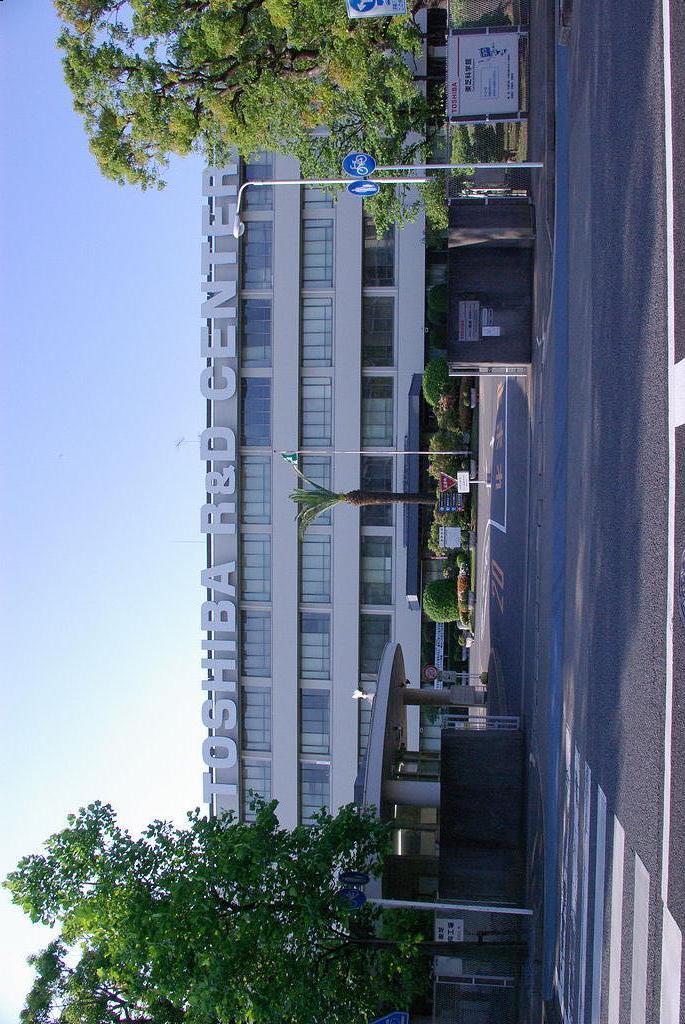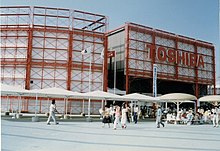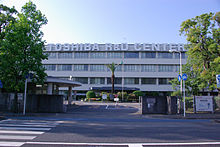Toshiba Corporation (株式会社東芝 Kabushiki-gaisha Tōshiba, English: /təˈʃiːbə, tɒ-, toʊ-/[2]), commonly known as Toshiba, is a Japanese multinational conglomerate headquartered in Tokyo, Japan. Its diversified products and services include information technology and communications equipment and systems, electronic components and materials, power systems, industrial and social infrastructure systems, consumer electronics, household appliances, medical equipment, office equipment, as well as lighting and logistics.
Toshiba was founded in 1939 as Tokyo Shibaura Denki K.K. through the merger of Shibaura Seisaku-sho (founded in 1875) and Tokyo Denki (founded in 1890). The company name was officially changed to Toshiba Corporation in 1978. Toshiba made a large number of corporate acquisitions during its history, including of Semp in 1977, of Westinghouse Electric LLC in 2006,[3] of Landis+Gyr in 2011, and IBM's point-of-sale business in 2012.
Toshiba is organized into four groupings: the Digital Products Group, the Electronic Devices Group, the Home Appliances Group and the Social Infrastructure Group. It is listed on the Tokyo Stock Exchange, where it is a constituent of the Nikkei 225 and TOPIX indices, the Osaka Securities Exchange and the Nagoya Stock Exchange. Toshiba is the seventh largest semiconductor manufacturer in the world.[citation needed]
On 11 April 2017, Toshiba filed unaudited quarterly results because of uncertainties at Westinghouse, which had filed for Chapter 11 bankruptcy protection. Toshiba stated that "substantial doubt about the company's ability to continue as a going concern exists".[4]
Toshiba was founded in 1939 by the merger of Shibaura Seisakusho (Shibaura Engineering Works)[5] and Tokyo Denki (Tokyo Electric). Shibaura Seisakusho had been founded as Tanaka Seisakusho by Tanaka Hisashige in July 1875 as Japan's first manufacturer of telegraph equipment.[6] In 1904, it was renamed Shibaura Seisakusho. Through the first decades of the 20th century, Shibaura Seisakusho had become a major manufacturer of heavy electrical machinery as Japan modernized during the Meiji Era and became a world industrial power. Tokyo Denki was founded as Hakunetsusha in 1890 and had been Japan's first producer of incandescent electric lamps. It later diversified into the manufacture of other consumer products and in 1899 had been renamed Tokyo Denki. The merger of Shibaura and Tokyo Denki created a new company called Tokyo Shibaura Denki (Tokyo Shibaura Electric) (東京 芝浦 電気). It was soon nicknamed Toshiba, but it was not until 1978 that the company was officially renamed Toshiba Corporation.
The group expanded rapidly, driven by a combination of organic growth and by acquisitions, buying heavy engineering and primary industry firms in the 1940s and 1950s. Groups created include Toshiba Music Industries/Toshiba EMI (1960), Toshiba International Corporation (1970s) Toshiba Electrical Equipment (1974), Toshiba Chemical (1974), Toshiba Lighting and Technology (1989), Toshiba America Information Systems (1989) and Toshiba Carrier Corporation (1999).
Toshiba is responsible for a number of Japanese firsts, including radar (1912), the TAC digital computer (1954), transistor television and microwave oven (1959), color video phone (1971), Japanese word processor (1978), MRI system (1982), laptop personal computer (1986), NAND EEPROM (1991), DVD (1995), the Libretto sub-notebook personal computer (1996) and HD DVD (2005).
In 1977, Toshiba acquired the Brazilian company Semp (Sociedade Eletromercantil Paulista), subsequently forming Semp Toshiba through the combination of the two companies' South American operations.
In 1987, Tocibai Machine, a subsidiary of Toshiba, was accused of illegally selling CNC milling machines used to produce very quiet submarine propellers to the Soviet Union in violation of the CoCom agreement, an international embargo on certain countries to COMECON countries. The Toshiba-Kongsberg scandal involved a subsidiary of Toshiba and the Norwegian company Kongsberg Vaapenfabrikk. The incident strained relations between the United States and Japan, and resulted in the arrest and prosecution of two senior executives, as well as the imposition of sanctions on the company by both countries.[9] Senator John Heinz of Pennsylvania said "What Toshiba and Kongsberg did was ransom the security of the United States for $517 million."
2000 to 2010
In 2001, Toshiba signed a contract with Orion Electric, one of the world's largest OEM consumer video electronic makers and suppliers, to manufacture and supply finished consumer TV and video products for Toshiba to meet the increasing demand for the North American market. The contract ended in 2008, ending seven years of OEM production with Orion.
In December 2004, Toshiba quietly announced it would discontinue manufacturing traditional in-house cathode ray tube (CRT) televisions. In 2006, Toshiba terminated production of in-house plasma TVs. To ensure its future competitiveness in the flat-panel digital television and display market, Toshiba has made a considerable investment in a new kind of display technology called SED. Before World War II, Toshiba was a member of the Mitsui Group zaibatsu (family-controlled vertical monopoly). Today Toshiba is a member of the Mitsui keiretsu (a set of companies with interlocking business relationships and shareholdings), and still has preferential arrangements with Mitsui Bank and the other members of the keiretsu. Membership in a keiretsu has traditionally meant loyalty, both corporate and private, to other members of the keiretsu or allied keiretsu. This loyalty can extend as far as the beer the employees consume, which in Toshiba's case is Asahi.
In July 2005, BNFL confirmed it planned to sell Westinghouse Electric Company, then estimated to be worth $1.8 billion (£1 billion).[10] The bid attracted interest from several companies including Toshiba, General Electric and Mitsubishi Heavy Industries and when the Financial Times reported on 23 January 2006 that Toshiba had won the bid, it valued the company's offer at $5 billion (£2.8 billion). The sale of Westinghouse by the Government of the United Kingdom surprised many industry experts, who questioned the wisdom of selling one of the world's largest producers of nuclear reactors shortly before the market for nuclear power was expected to grow substantially; China, the United States and the United Kingdom are all expected to invest heavily in nuclear power.[11] The acquisition of Westinghouse for $5.4 billion was completed on 17 October 2006, with Toshiba obtaining a 77 percent share, and partners The Shaw Group a 20 percent share and Ishikawajima-Harima Heavy Industries Co. Ltd. a 3 percent share.
In late 2007, Toshiba took over from Discover Card as the sponsor of the top-most screen of One Times Square in New York City.[12] It displays the iconic 60-second New Year's countdown on its screen, as well as messages, greetings, and advertisements for the company.
In January 2009, Toshiba acquired the HDD business of Fujitsu.[13][14]
2010 to 2013
Toshiba announced on 16 May 2011, that it had agreed to acquire all of the shares of the Swiss-based advanced-power-meter maker Landis+Gyr for $2.3 billion.[15] In 2010 the company released a series of television models including the WL768, YL863, VL963 designed in collaboration with Danish designer Timothy Jacob Jensen.[16]
In April 2012, Toshiba agreed to acquire IBM's point-of-sale business for $850 million, making it the world's largest vendor of point-of-sale systems.[17][18]
In July 2012, Toshiba was accused of fixing the prices of LCD panels in the United States at a high level. While such claims were denied by Toshiba,[19] they have agreed to settle alongside several other manufacturers for a total of $571 million.[20]
In December 2013, Toshiba completed its acquisition of Vijai Electricals Limited plant at Hyderabad & set up its own base for manufacturing of Transmission & Dist
ribution products(Transformers & Switchgears) under the Social Infrastructure Group in India as Toshiba Transmission & Distribution Systems (India) Private Limited.
2014 OCZ Storage Solutions Acquisition
In January 2014, Toshiba completed its acquisition of OCZ Storage Solutions.[21] OCZ Technology stock was halted on 27 November 2013. OCZ then stated they expected to file a petition for bankruptcy and that Toshiba Corporation had expressed interest in purchasing its assets in a bankruptcy proceeding.[22][23] On 2 December 2013, OCZ announced Toshiba had agreed to purchase nearly all of OCZ's assets for $35 million.[24] The deal was completed on 21 January 2014 when the assets of OCZ Technology Group became a new independently-operated subsidiary of Toshiba named OCZ Storage Solutions.[25] OCZ Technology Group then changed its name to ZCO Liquidating Corporation;[26] on 18 August 2014, ZCO Liquidating Corporation and its subsidiaries were liquidated.[27]OCZ Storage Solutions was dissolved on 1 April 2016 and absorbed into Toshiba America Electronic Components, Inc.,[28][29] with OCZ becoming a brand of Toshiba.
In March 2014, Toshiba sued SK Hynix accusing the company for stealing technology of their NAND flash memory.[30]
In October 2014, Toshiba and United Technologies agreed a deal to expand their joint venture outside Japan.[31]
Toshiba announced in early 2015 that they would stop making televisions in its own factories. From 2015 onward, Toshiba televisions will be made by Compal for the U.S., or by Vestel and other manufacturers for the European market.
In January 2016, Toshiba's security division unveiled a new bundle of services for schools that use its surveillance equipment. The program, which is intended for both K-12 and higher education, includes education discounts, alerts and post-warranty support, among other features, on its IP-based security gear.[32]
As of March 2016, Toshiba is preparing to start construction on a cutting-edge new semiconductor plant in Japan that will mass-produce chips based on the ultra-dense flash variant. Toshiba expects to spend approximately 360 billion yen, or $3.2 billion, on the project through May 2019.[33]

In April 2016, Toshiba recalled 100,000 faulty laptop lithium-ion batteries, which are made by Panasonic, that can overheat, posing burn and fire hazards to consumers, according to the U.S. Consumer Product Safety Commission. Toshiba first announced the recall in January, and said it was recalling the batteries in certain Toshiba Notebook computers sold since June 2011.[34]
In September 2016, Toshiba announced the first wireless power receiver IC using the Qi 1.2.2 specification, developed in association with the Wireless Power Consortium.[35]
In late December 2016 Toshiba announced losses in the Westinghouse subsidiary from nuclear plant construction would lead to a write-down of several billion dollars.[36]
In January 2017, a person with direct knowledge of the matter reported that the company plans on making its chip division a separate business.[37]
2015 accounting scandal
Toshiba first announced in May 2015 that it was investigating an accounting scandal and it might have to revise its profits for the previous three years.[38][39] On 21 July 2015, CEO Hisao Tanaka announced his resignation amid an accounting scandal that he called "the most damaging event for our brand in the company's 140-year history." Profits had been inflated by $1.2 billion over the previous seven years.[40] Eight other senior officials also resigned, including the two previous CEOs.[41] Chairman Masashi Muromachi was appointed acting CEO.[42] Following the scandal, Toshiba Corp. was removed from a stock index showcasing Japan's best companies. That was the second reshuffle of the index, which picks companies with the best operating income, return on equity and market value.[43]
In September 2015, Toshiba shares fell to their lowest point in two and a half years. The firm said in a statement that its net losses for the quarterly period were 12.3 billion yen ($102m; £66m). The company noted poor performances in its televisions, home appliances and personal computer businesses.[44]
In December 2015, Muromachi said the episode had wiped about $8 billion off Toshiba's market value. He forecast a record 550 billion yen (about US $4.6 billion) annual loss and warned the company would have to overhaul its TV and computer businesses. Toshiba would not be raising funds for two years, he said. The next week, a company spokesperson announced Toshiba would in early 2016 seek 300 billion yen ($2.5 billion), taking the company's indebtedness to more than 1 trillion yen (about $8.3 billion).[45]
In May 2016, it was announced that Satoshi Tsunakawa, the former head of Toshiba's medical equipment division, was named CEO. This appointment came after the accounting scandal that occurred.[46][47]
2017 US nuclear construction liabilities
In February 2017, Toshiba revealed unaudited details of a 390 billion yen ($3.4 billion) corporate wide loss, mainly arising from its majority owned US based Westinghouse nuclear construction subsidiary which was written down by 712 billion yen ($6.3 billion). On 14 February 2017, Toshiba delayed filing financial results, and chairman Shigenori Shiga, formerly chairman of Westinghouse, resigned.[48][49][50]
Construction delays, regulatory changes and cost overruns at Westinghouse built nuclear facilities Vogtle units 3 and 4 in Waynesboro, Georgia and VC Summer units 2 and 3 in South Carolina, are cited as the main causes of the dramatic fall in Toshiba's financial performance and collapse in share price. Fixed priced construction contracts negotiated by Westinghouse with Georgia Power have left Toshiba with uncharted liabilities that will likely result in the sale of key Toshiba operating subsidiaries to secure the company's future.[51]
Westinghouse filed for Chapter 11 bankruptcy protection on 29 March 2017.[52][53] It was estimated this would cost 9 billion dollar annual net loss.[54]
On 11 April 2017, Toshiba filed unaudited quarterly results. Auditors PricewaterhouseCoopers had not signed of the accounts because of uncertainties at Westinghouse. Toshiba stated that "substantial doubt about the company's ability to continue as a going concern exists".[4][55] On 25 April 2017, Toshiba announced its decision to replace its auditor after less than a year. Earlier in April, the company filed twice-delayed business results without an endorsement from auditor PricewaterhouseCoopers (PwC).[54][56]
On 20 September 2017, Toshiba's board approved a deal to sell its memory chip business to a group led by Bain Capital for US$18 billion, with financial backing by companies such as Apple, Dell Technologies, Hoya Corporation, Kingston Technology, Seagate Technology, and SK Hynix.[57][58] On 15 November 2017, Hisense reached a deal to acquire 95% of Toshiba Visual Solutions for US$113.6 million.[59]
Later that month, the company announced that it would pull out of its long-standing sponsorships of the Japanese television programs Sazae-san, Nichiyo Gekijo, and the video screens topping out One Times Square in New York City. The company cited that the value of these placements were reduced by its exit from consumer-oriented lines of business.[60]
On 6 April 2018 Toshiba announced the completion of the sale of Westinghouse's holding company to Brookfield Business Partners and some partners.[61]
Operations
Toshiba is headquartered in Minato-ku, Tokyo, Japan and has operations worldwide. It had around 210,000 employees as of 31 March 2012.[62]
Toshiba is organised into four main business groupings: the Digital Products Group, the Electronic Devices Group, the Home Appliances Group and the Social Infrastructure Group.[62] In the year ended 31 March 2012, Toshiba had total revenues of ¥6,100.3 billion, of which 25.2 percent was generated by the Digital Products Group, 24.5 percent by the Electronic Devices Group, 8.7 percent by the Home Appliances Group, 36.6 percent by the Social Infrastructure Group and 5 percent by other activities. In the same year, 45 percent of Toshiba's sales were generated in Japan and 55 percent in the rest of the world.[62]
Toshiba has 39 R&D facilities worldwide, which employ around 4,180 people.[62] Toshiba invested a total of ¥319.9 billion in R&D in the year ended 31 March 2012, equivalent to 5.2 percent of sales.[62] Toshiba registered a total of 2,483 patents in the United States in 2011, the fifth-largest number of any company (after IBM, Samsung Electronics, Canon and Panasonic).[62]
Principal business groupings, divisions and subsidiaries
Toshiba is organized into the following principal business groupings, divisions and subsidiaries:
- Digital Products Group
- Digital Products and Services Company
- Network & Solution Control Center
- Toshiba TEC Corporation
- Electronic Devices Group
- Semiconductor & Storage Products Company
- Discrete Semiconductor Division
- Analog & Imaging IC Division
- Logic LSI Division
- Memory Division
- Storage Products Division
- Center For Semiconductor Research & Development
- Optical Disc Drive Division (Formed partnership with optical disc drive division of Samsung Electronics as Toshiba Samsung Storage Technology Corporation (TSST))[63][64][65]
- Toshiba Mobile Display Co., Ltd. (This company will be merged with Hitachi Displays, Ltd. and Sony Mobile Display Corporation to form Japan Display Inc. in Spring of 2012.[66])
- Social Infrastructure Group
- Power Systems Company (Combined-cycle gas power plants, nuclear power plants, hydro-electric power plants, and associated components)
- Nuclear Energy Systems & Services Division
- Westinghouse Electric Company (Acquired October 2006)
- Thermal & Hydro Power Systems & Services Division
- Power and Industrial Systems Research and Development Center
- Social Infrastructure Systems Company[67]
- Transmission & Distribution Systems Division
- Railway & Automotive Systems Division
- Railway Systems Division
- Automotive Systems Division
- Motor & Drive Systems Division
- Automation Products & Facility Solution Division
- Defense & Electronic Systems Division
- Environmental Systems Division
- Toshiba Elevator and Building Systems Corporation
- Toshiba Solutions Corporation
- Toshiba Medical Systems Corporation
- Toshiba America Information Systems
- Home Appliances Group
- Toshiba Home Appliances Corporation
- Toshiba Lighting & Technology Corporation
- Harison Toshiba Lighting Corporation
- Toshiba Carrier Corporation
- Others
- New Lighting Systems Division
- Smart Community Division
- Materials & Devices Division
Products, services and standards
Toshiba has a range of products and services, including air conditioners,[68] consumer electronics (including televisions and DVD and Blu-ray players),[69] control systems (including air-traffic control systems, railway systems, security systems and traffic control systems),[70] electronic point of sale equipment,[71] elevators and escalators,[72] home appliances (including refrigerators and washing machines),[68] IT services,[73] lighting,[68][74] materials and electronic components,[75] medical equipment (including CT and MRI scanners, ultrasound equipment and X-ray equipment),[76] office equipment,[71][77] business telecommunication equipment[78] personal computers,[69] semiconductors,[79] power systems (including electricity turbines, fuel cells and nuclear reactors)[80] power transmission and distribution systems,[70] and TFT displays.[81]You're using 5.3 KB of your 20 MB diskspace allowed.









